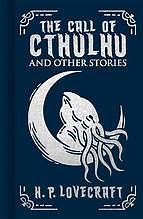You need to sign in or sign up before continuing.
Take a photo of a barcode or cover
I really enjoyed alot of these short stories. I don't really like first-person which put me off and the racism wasn't great. But it had beautiful prose and I really liked "the rats in the wall", "He" and "The call of Cthulhu". It wasn't scary but I imagine that I would have felt different if I lived when it was written.
All in all a good read!
All in all a good read!
dark
mysterious
fast-paced
It was okay. Just not scary at all.
dark
tense
medium-paced
Plot or Character Driven:
A mix
Strong character development:
No
Loveable characters:
No
Diverse cast of characters:
No
Flaws of characters a main focus:
No
Moderate: Death, Racism
challenging
dark
mysterious
tense
medium-paced
Plot or Character Driven:
Plot
Strong character development:
No
Loveable characters:
No
Diverse cast of characters:
No
Flaws of characters a main focus:
No
dark
tense
slow-paced
Plot or Character Driven:
Plot
Strong character development:
No
Loveable characters:
Complicated
Diverse cast of characters:
Complicated
Flaws of characters a main focus:
Complicated
So racist, it hurts. Lovecraft bases his "horrifying" sagas in tired racist voodoo tropes, "ancient red Indian rituals", etc. Perhaps a writing style of Lovecraft's time, but the lack of adjectives makes for lazy writing to my contemporary senses. The writing was annoyingly coy with sentences like, "I do not try to account for that *thing*, nor can I venture to describe it in details, since the first words took away my consciousness and created a mental blank which reaches to the time of my awakening in the hospital." A lot of words to say not much at all.
If he was out to shock and titillate, I didn't get much of it, except maybe in The Rats In The Wall, which was very gross, and exactly what I was looking to read from Lovecraft.
That said, Lovecraft's legacy inspired countless amazing literature, and I'm grateful for those new works.
If he was out to shock and titillate, I didn't get much of it, except maybe in The Rats In The Wall, which was very gross, and exactly what I was looking to read from Lovecraft.
That said, Lovecraft's legacy inspired countless amazing literature, and I'm grateful for those new works.
I feel like this book is a little bit tricky for me to review. I am by no means an accomplished reader of the horror genre and am almost completely ignorant of the history of this particular niche. I understand, from a little bit of Googling, that Lovecraft was a pioneer of a sub-genre that has continued and grown well after his death. His ‘Cthulhu mythos’ has not only created many imitators but sparked board games, RPGs, video games and all sorts of spin-offs. So there must be something here.
I confess I don’t really get it though.
I found very few of these stories gripping or creepy and none of them got close to what I would describe as scary. There are a few troupes in here that reoccur and I think undermine any sense of horror. Firstly, there is the frequent description of things as strange/terrible/horrible/otherworldly ‘beyond description’. Used sparingly it is a nice get out to let the reader’s imagination run wild, but when it's used multiple times in every story it just feels like lazy writing. The second, which I think is worse, is that many of the stories are told in the first person by people who have already experienced some horrible thing and are now telling us about it or else are relating the correspondence of some acquaintance who experienced something strange. I found this put a lot of space between me and the horror. Nothing felt immediate, it was like watching everything from a great distance - you can’t help but be impacted by it less strongly.
Those few stories that move away from this structure are quite a bit better. I thought that Nyarlathotep was strange and atmospheric. The Picture in the House, which follows it, is for my money the best of the bunch. Here, there is a genuine sense of menace which grows out of uneasiness and into something truly gruesome. You also feel as though you spot the danger well before the protagonist, giving that wonderful ‘don’t go down there!’ feeling as you will the character to get out of dodge before it is too late.
Sadly these few great stories don’t quite redeem the collection for me. Perhaps H.P. Lovecraft is just of his time. Perhaps this is more of interest to those steeped in this genre. Either way, this book probably wasn’t for me.
I confess I don’t really get it though.
I found very few of these stories gripping or creepy and none of them got close to what I would describe as scary. There are a few troupes in here that reoccur and I think undermine any sense of horror. Firstly, there is the frequent description of things as strange/terrible/horrible/otherworldly ‘beyond description’. Used sparingly it is a nice get out to let the reader’s imagination run wild, but when it's used multiple times in every story it just feels like lazy writing. The second, which I think is worse, is that many of the stories are told in the first person by people who have already experienced some horrible thing and are now telling us about it or else are relating the correspondence of some acquaintance who experienced something strange. I found this put a lot of space between me and the horror. Nothing felt immediate, it was like watching everything from a great distance - you can’t help but be impacted by it less strongly.
Those few stories that move away from this structure are quite a bit better. I thought that Nyarlathotep was strange and atmospheric. The Picture in the House, which follows it, is for my money the best of the bunch. Here, there is a genuine sense of menace which grows out of uneasiness and into something truly gruesome. You also feel as though you spot the danger well before the protagonist, giving that wonderful ‘don’t go down there!’ feeling as you will the character to get out of dodge before it is too late.
Sadly these few great stories don’t quite redeem the collection for me. Perhaps H.P. Lovecraft is just of his time. Perhaps this is more of interest to those steeped in this genre. Either way, this book probably wasn’t for me.
Let's get the harsh stuff out of the way: I did not love this collection. I found many of the stories, particularly the ones in the first half of the book (which were also the earliest-written stories) poorly-executed and only half-thought-through. Lovecraft is widely-praised for his ability to create a new kind of horror, one of slowly-creeping insanity often due to the realization that the main character and/or mankind in general is an insignificant speck in the face of the unknown and unknowable universe. That being said: he was often a lot better in the idea phase than in the execution.
The biggest issue that I have with this collection is that many of the stories are very, very dated. Many of the stories are peppered liberally with what seem like cliches, except at the time, they weren't cliches: they were new and fresh ideas. I don't know why I can't get over early genre cliches the same way I can get over early film cliches - I watch classic silent and early sound movies and really enjoy them - but that's a big stumbling block for me. It also doesn't help that he re-works ideas from his earlier stories into (usually) much better and longer later stories; the repetition of themes and ideas in this collection sometimes gave me the feeling that he lacked depth and imagination.
(Another thing that doesn't help is his not-so-subtle xenophobia that borders on racism. It's not there in all the stories, but when it is there, hoooo BOY it is not pleasant. And this isn't just the Mark Twain, "a product of his times," uncomfortable-yet-important kind of writing. This is a man who is clearly afraid of and distrustful of other cultures and who incorporates those fears and dislikes into his stories. It's the kind of subtext that can kill the sense of paranoia and terror that he's trying to craft.)
That being said, however, there are some really good stories in this collection as well. Some of the earlier stories, such as "The Rats in the Walls" and "Herbert West -- Reanimator" are absolute gems, excellent studies in tone, genre, and creepiness. "The Rats in the Walls," in particular, was a standout: when you start a story by saying that you wish you had never learned about to the house of your ancestors, and now it is being BLOWN UP, that is a pretty damn great hook. The fact that he completely delivered on that promise made for a really great story, one that kept me going through the rest of the collection, hoping for a story that might even exceed it.
And a number of the later stories are very good too; although longer and sometimes overstuffed with flowery descriptions, I think Lovecraft became a more skilled writer over time, and his descriptions of the places and the eerie feelings that slowly begin to overwhelm his narrators are more effective towards the end of the book. My two favourite stories are from the end of the book. The first, "Shadow Over Innsmouth," featured terrific descriptions of slowly mounting unease and a narrator that was actually active and dynamic (well, active and dynamic by Lovecraft's standards), and it had a great ending that actually raised the hairs on my arms. The second and the best of the collection, was "The Color out of Space," is a very languidly paced but vividly described tale of a mysterious meteor that crashes on a patch of farmland and releases an indescribable "color" that slowly begins infecting the land...then the animals...then the people. Even now, weeks after reading the story, I can recall Lovecraft's unsettling descriptions of the images and events of the story and get subtly creeped out.
So overall, I would say that The Call of Cthulhu and Other Weird Stories was worth reading. Although the colleciton is definitely uneven, the ideas he put forth in some of his poorer stories are still powerful upon reflection. There were also a handful of truly excellent stories that I would love to re-read again in the future, and it was a decent introduction to a writer whose influence stretches beyond his time and genre, even if many readers (including a younger me) don't realize it.
The biggest issue that I have with this collection is that many of the stories are very, very dated. Many of the stories are peppered liberally with what seem like cliches, except at the time, they weren't cliches: they were new and fresh ideas. I don't know why I can't get over early genre cliches the same way I can get over early film cliches - I watch classic silent and early sound movies and really enjoy them - but that's a big stumbling block for me. It also doesn't help that he re-works ideas from his earlier stories into (usually) much better and longer later stories; the repetition of themes and ideas in this collection sometimes gave me the feeling that he lacked depth and imagination.
(Another thing that doesn't help is his not-so-subtle xenophobia that borders on racism. It's not there in all the stories, but when it is there, hoooo BOY it is not pleasant. And this isn't just the Mark Twain, "a product of his times," uncomfortable-yet-important kind of writing. This is a man who is clearly afraid of and distrustful of other cultures and who incorporates those fears and dislikes into his stories. It's the kind of subtext that can kill the sense of paranoia and terror that he's trying to craft.)
That being said, however, there are some really good stories in this collection as well. Some of the earlier stories, such as "The Rats in the Walls" and "Herbert West -- Reanimator" are absolute gems, excellent studies in tone, genre, and creepiness. "The Rats in the Walls," in particular, was a standout: when you start a story by saying that you wish you had never learned about to the house of your ancestors, and now it is being BLOWN UP, that is a pretty damn great hook. The fact that he completely delivered on that promise made for a really great story, one that kept me going through the rest of the collection, hoping for a story that might even exceed it.
And a number of the later stories are very good too; although longer and sometimes overstuffed with flowery descriptions, I think Lovecraft became a more skilled writer over time, and his descriptions of the places and the eerie feelings that slowly begin to overwhelm his narrators are more effective towards the end of the book. My two favourite stories are from the end of the book. The first, "Shadow Over Innsmouth," featured terrific descriptions of slowly mounting unease and a narrator that was actually active and dynamic (well, active and dynamic by Lovecraft's standards), and it had a great ending that actually raised the hairs on my arms. The second and the best of the collection, was "The Color out of Space," is a very languidly paced but vividly described tale of a mysterious meteor that crashes on a patch of farmland and releases an indescribable "color" that slowly begins infecting the land...then the animals...then the people. Even now, weeks after reading the story, I can recall Lovecraft's unsettling descriptions of the images and events of the story and get subtly creeped out.
So overall, I would say that The Call of Cthulhu and Other Weird Stories was worth reading. Although the colleciton is definitely uneven, the ideas he put forth in some of his poorer stories are still powerful upon reflection. There were also a handful of truly excellent stories that I would love to re-read again in the future, and it was a decent introduction to a writer whose influence stretches beyond his time and genre, even if many readers (including a younger me) don't realize it.
dark
mysterious
tense
fast-paced
Plot or Character Driven:
Plot
Graphic: Death, Gore, Racial slurs, Racism, Xenophobia, Cannibalism, Classism




